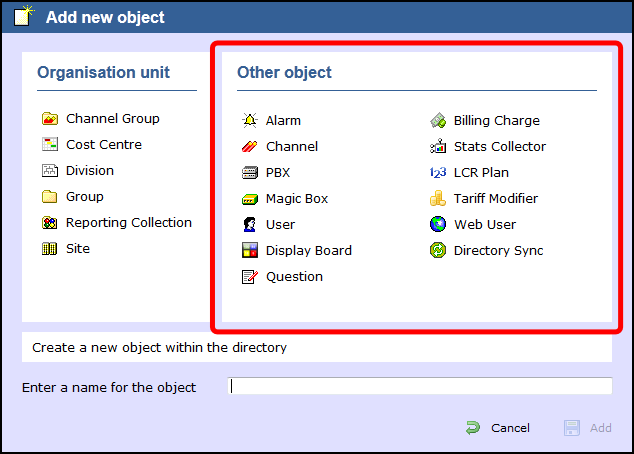The Other objects section consists of a list of different objects, each representing an additional feature you can add to the call logger, such as call recording integration, directory sync, display boards etc.

The objects available are presented in the table below:
| Object | Description |
|---|---|
An Alarm object can be set up at any level of the Directory in order to trigger an alert when calls whose properties match certain criteria have happened, such as calls above a particular duration, calls to specific phone numbers, or when user-defined cost thresholds are exceeded. The criteria that must be met to trigger an alarm is user-defined, and email alerts can be sent to one or more recipients. | |
Channels are system objects representing your telephone lines. When you first configure the system, your channels are automatically harvested from the data received from the phone system. The properties of each channel can be edited afterwards, and channels can also be organised subsequently into new groups, if preferred. | |
The function of a PBX object is to acquire call logging data from a telephone system. TIM Enterprise can be configured to take call records from a single PBX covering multiple sites or you can connect to a number of PBXs. | |
The Magic Box object allows you to integrate a call recording device to TIM Enterprise. By adding one or more of our supported voice recording options, it is possible to store the audio recording of every telephone call that TIM Enterprise processes. | |
Users represent the people in your organisation who make use of devices such as telephone extensions, fax machines, etc. When you first configure the system, your users are automatically harvested from the data received from the phone system. The properties of each user can be edited afterwards, and users can also be subsequently organised into new user groups, if preferred. | |
A display board is a user-definable screen that can comprise any live, up-to-the-minute information, such as call statistics, leaderboards or RSS feeds. It can also pull content from third-party systems, such as sales management, accounting or CRM software. | |
| Question | A Question object can be added to the Directory to allow users to score calls. By defining a list of questions, you can apply this to each call that you score, in order to rate calls for evaluation purposes. |
Billing charges allow to add additional charges or markups to calls, users or bills. Billing charges can be applied as a percentage or fixed charge. When several charges are added to a bill, the charges can be prioritised according to their importance. | |
A stats collector is a mathematical "counter" that can be placed on any subject and whose scope of data collection is determined by its placement in your directory hierarchy. As calls are made and received, the properties of each one are collated for future consumption by display boards. | |
LCR Plans can be placed anywhere in the Directory in order to apply your call routing plans for costing purposes. | |
Tariff Modifiers can be placed anywhere in the Directory in order to apply different rates to the designated object. | |
When accessing TIM Enterprise you are required to enter a username and password in the web browser, which form a login credential known as Web user. Web user can be allowed access to the entire system or restricted to any specific area of your Directory. | |
The Directory sync object in TIM Enterprise allows you to sync any partition of TIM Enterprise with a third-party directory, such as Active Directory or Cisco AXL. |